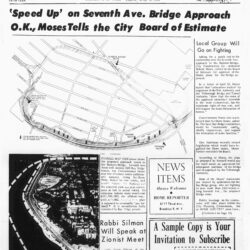
In Bay Ridge, Stability Is Name Of the Game
By Raanan Geberer
Brooklyn Daily Eagle
BAY RIDGE — Looking at statistics for Community District 10, which covers Bay Ridge, Fort Hamilton and Dyker Heights (sometimes collectively called “Greater Bay Ridge”), one is struck by the amount of stability.
The area clearly has good numbers in terms of income, health, housing and employment. And comparing figures from 2007–09 to figures from 2000 shows that these numbers have been consistent.
The greatest visible changes are an increase in the Asian population, which grew from 12.8 percent to 19.2 percent, and a slight decline in the white population, from 69 to 66 percent.
These figures are from the Brooklyn Neighborhood Report on Community District 10, one of a series of such reports (one for each community district) published recently by the Center for the Study of Brooklyn at Brooklyn College. The neighborhood reports are co-sponsored and funded by the Brooklyn Community Foundation.
The online report is illustrated with photos of a row of brownstones, an expensive house on Shore Road, the 69th Street Pier, Fort Hamilton High School, the Narrows Botanical Garden and the venerable Hinsch’s Ice Cream Parlor. These images combine to convey an impression of a pleasant, familiar lifestyle. Many residents compare Bay Ridge to a small town.
According to the report, the top five ethnicities within the community district in 2007–09 were Italian, Chinese, Irish, Greek and Puerto Rican. The main change seen in comparison with a similar ranking from 2000 is that Puerto Ricans edged Russians out of the top five.
Of the total population in 2007–09, 54 percent were born in New York state, with second place, China, far behind at 8 percent. Similarly, 47 percent of Community Board 10 residents in 2007–09 spoke English in the home, according to the report, with Chinese in second place at 13 percent.
The number of residents with a bachelor’s degree rose slightly from 32.1 percent in 2000 to 35.9 percent in 2007–09. Sixty– three percent of all graduating high school students enrolled in college, much higher than the borough-wide number of 48 percent.
The four most common professions of Community District 10 residents were unchanged from 2000 to 2007–09. They were, in order, administrative assistant, elementary school teacher, accountant and retail salesperson. The median household income rose from $52,858 to $54,807.
In terms of housing, 36 percent of all renters paid more than 30 percent of their income for apartments, well below the borough-wide figure of 55 percent. The median gross rent rose from $988 in 2000 to $1,206 in 2007–09.
As far as foreclosures were concerned, there was an average of only five per 1,000 homeowners in 2007–09, compared to an average of 25 foreclosures per 1,000 borough-wide.
In addition to being economically stable, Greater Bay Ridge is also a healthy place. Ninety-five percent of all residents reported eating one to four servings of fresh fruits and vegetables every day, and the great majority reported themselves to be in good, very good or excellent health. Seventy-one percent exercised within the past 30 days.
Showing an increased health consciousness, cigarette smoking within Community District 10 decreased from 24 percent in 2000 to 19 in 2007–09, and binge drinking decreased from 13.4 percent to 10.4. The rate of obesity increased from 17.4 to 19.7 percent, but this was still considerably lower than the borough-wide rate of 25 percent.
Finally, 68.8 percent of all citizens were registered to vote in 2007–09, lower than 79.8 percent in the borough as a whole. However, of those registered voters, a slightly higher percentage voted in the 2008 presidential election than in the entire borough.
Leave a Comment
Leave a Comment


